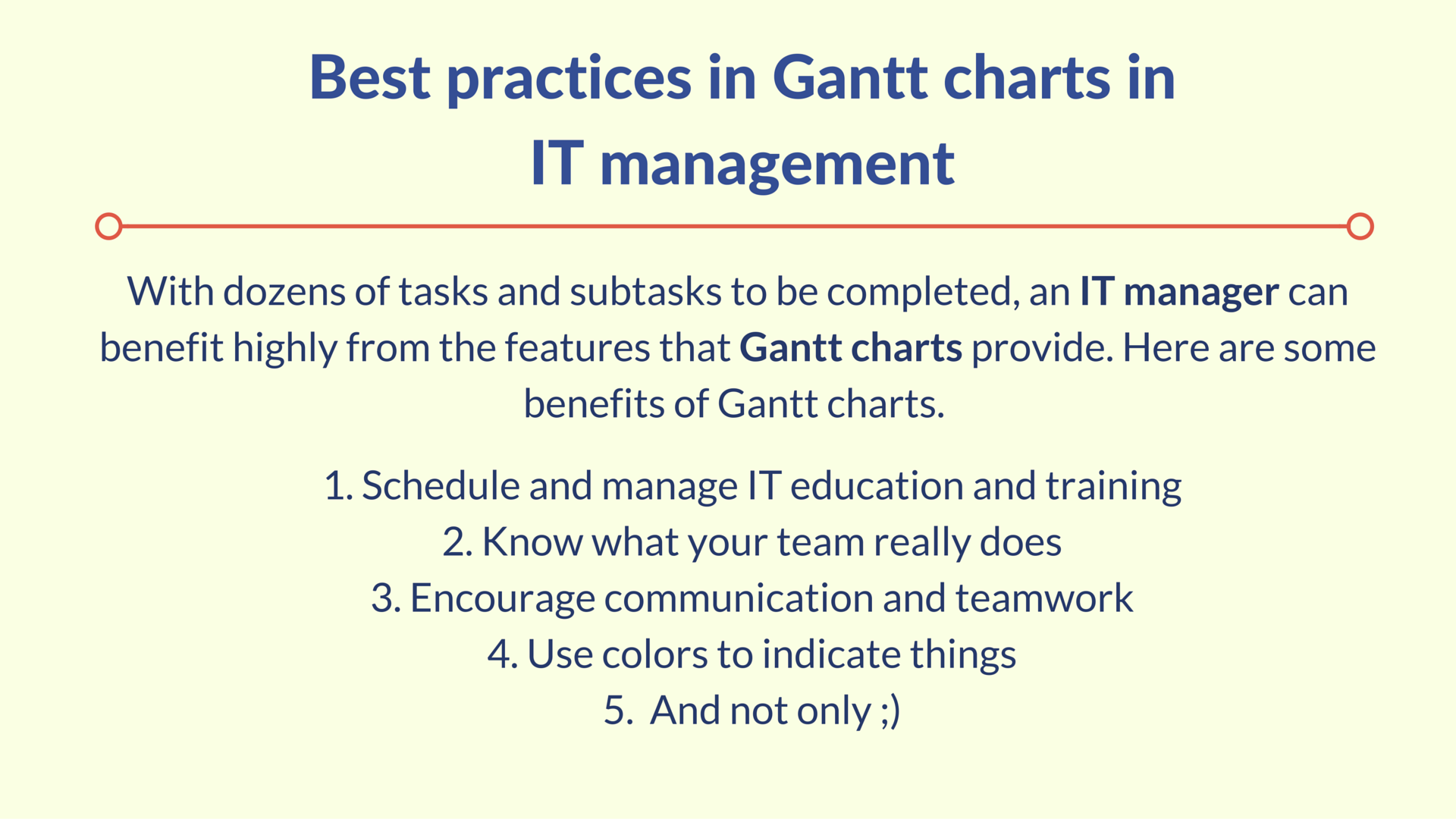With dozens of tasks and subtasks to be completed, an IT manager can benefit highly from the features that Gantt charts provide. For example, when setting up a Gantt chart, you need to think about all the tasks included in the project to be able to assign them to each of your team players. During this process, you will decide who is doing what in which time frame. Let’s look at some best practices in Gantt charts in IT management.
Schedule and manage IT education and training
Your IT people need training and further education. In large teams, there are jobs that a single employee does all the time. You need to train some of your team players to do that same job in case that person gets sick or goes on vacation or simply quits his job or whatever other reason. The point is to have a back up.
Know what your team really does
Being an IT manager doesn’t mean you should be able to do what each of your team members does. However, being familiar with the list of tasks and subtasks they are doing is a must. A Gantt chart will help you organize the staff’s normal work routine. Thus, you will be able to see the responsibilities of each of them including, but not limited to tasks such as:
- Merging multiple databases
- Creating new desktop pictures
- Creating custom-design websites
- Updating networks and software
- Adding or removing servers
- Developing mobile applications
- Installing or removing online work platforms
One more important thing here; some IT project managers do the work for their employees because they think new employees are not experienced enough to complete their tasks on time. This is the worst approach towards organizing work. With Gantt charts, you will be able to coach and help your employees by scheduling their tasks, but never do their jobs for them.
Encourage communication and teamwork
With a Gantt chart, everyone can see what others have to do. Information about responsibilities and deadlines is easily shared this way, making communication between teams easier. Besides, slight changes in one area may result in crucial drawbacks in others. Hence, it is useful to have everything in one place so that everyone sees which tasks are prioritized as important ones and which ones can be completed later on. Moreover, if you change something in the chart, it will be visible for all team players.
Provide feedback based on the data gathered through Gantt charts
With a Gantt chart, an IT project manager can collect lots of useful information about the ongoing tasks his/her staff is working on. For example, you can track the progress of each task and provide proper feedback accordingly. Some IT tasks make people feel isolated as they are working on them independently and make decisions themselves. With a Gantt chart, you will be able to see what your staff is doing and let them know what they are doing well and what needs to be improved. You can provide feedback either privately with an email or through business chat. Or you can do that during formal performance reviews and staff meetings.

Use colors to indicate things
Do not underestimate the value of colors when using a Gantt chart. You can use a hierarchy of colors to indicate things. For example, blue can mean tasks that are OK and that are going on quite well. Orange can indicate a warning. You can use it to show that something needs to be done faster. Red can indicate trouble. When a deadline is past due, red can indicate that as well
You can also use the same colors for a group of interconnected activities. For example, you can use pink for all IT tasks related to website design and you can use green to indicate tasks related to mobile applications and so on.
Document results and experience with Gantt charts
By preserving a Gantt chart with completed work, you will be able to benefit from it further on too. Use it for documenting the work done. It can be a nice example for other IT projects you will have in the future. Experience in previous work is highly valued in IT projects as it can help an IT manager avoid lots of managerial troubles.
Customers expect high-quality, cost-effective and fast results from IT people. Hence, the objectives of IT projects will be:
- Effective management of processes
- Consideration of size and volume of the tasks to be completed
- The use of the right tools to enhance work efficiency
An IT project manager always needs to plan, monitor and control processes and a Gantt chart will be useful for the following things:
- Quality management
- Risk management
- Progress tracking
- Communication enhancement
With their multiple benefits, Gantt charts can become a top management tool for your IT projects. Even if your IT geeks are not so communicative, you will be able to improve collaboration between teams since everyone’s tasks will be on the same platform and accordingly, everyone will know whom to turn to for deliverables or in case of questions. As a result, decisions will be made more quickly. And if there is a need to change something in the project, your teams will be aware of it as soon as the change is made. You save time and energy, as well as maintain a healthy working environment free of miscommunication and conflicts. If you have ever used Gantt charts in your IT project management we would highly appreciate your ideas regarding its pros and cons. You can share ideas below by adding a comment.
Follow us


